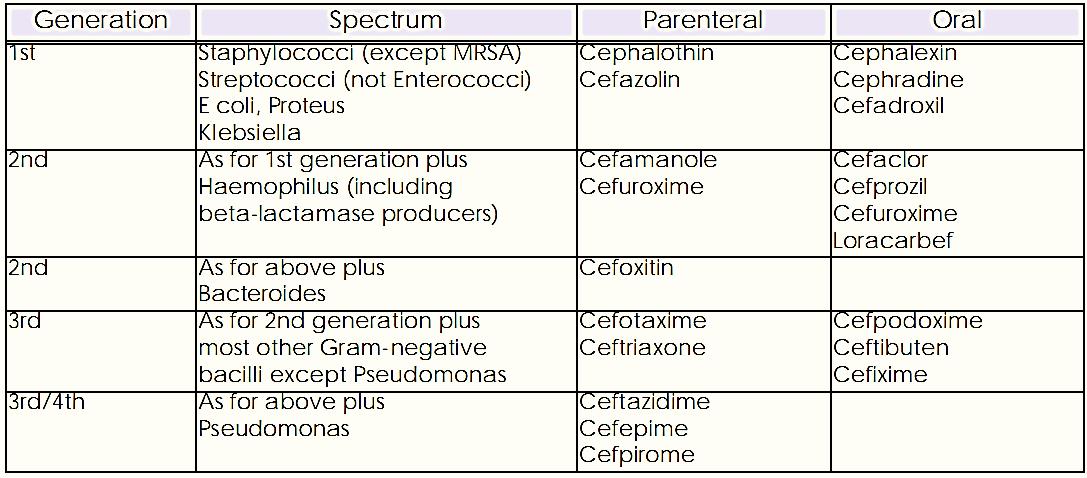


 النبات
النبات
 الحيوان
الحيوان
 الأحياء المجهرية
الأحياء المجهرية
 علم الأمراض
علم الأمراض
 التقانة الإحيائية
التقانة الإحيائية
 التقنية الحيوية المكروبية
التقنية الحيوية المكروبية
 التقنية الحياتية النانوية
التقنية الحياتية النانوية
 علم الأجنة
علم الأجنة
 الأحياء الجزيئي
الأحياء الجزيئي
 علم وظائف الأعضاء
علم وظائف الأعضاء
 الغدد
الغدد
 المضادات الحيوية
المضادات الحيوية|
Read More
Date: 23-3-2016
Date: 24-3-2016
Date: 24-3-2016
|
Cephalosporins
The cephalosporins are o group of broad-spectrum antibiotics, which are conveniently grouped into 3 generations, with increasing activity against Gram-negative aerobes, and somewhat decreasing Gram-positive activity. The table below shows o simplistic grouping based on their spectra of activity.

General Notes
All are active against most streptococci, except Enterococcus spp. (which are all intrinsically resistant). importantly, they also have no activity against Listeria or methicillin-resistant staphylococci. Most penicillin-allergic patients will tolerate cephalosporins. but this group of antibiotics should be avoided if there is a definite history of anaphylaxis after penicillin administration. ln general, the third-generation cephalosporins are significantly less active against staphylococci than the first- and second generation cephalosporins.
First-generation cephalosporins
The first-generation cephalosporins are effective alternatives for treating staphylococcal and streptococcal infections. They are therefore alternatives for skin and soft-tissue infections, as well as for streptococcal pharyngitis. lt is important to stress that the members of this generation are not indicated for empiric treatment of otitis media or sinusitis. Although these agents have some activity against E. coll. Klebsiella and Proteus. their use is limited to urinary tract infections caused by susceptible strains of these organisms.
Second-generation cephalosporins
The second-generation cephalosporins have increased activity against Gram-negative bacteria, including H. influenzae, N. meningitidis and M. catarrhalis. They are therefore useful agents for treating upper and lower respiratory tract infections, sinusitis and otitis media. These agents are also active against E. coll. Klebsiella and Proteus, which makes them potential alternatives for treating urinary tract infections caused by these organisms. Cefoxitin is o second-generation cephalosporin with anaerobic activity, and although seldom used as o therapeutic agent, it may have o role for prophylaxis in gastrointestinal surgery.
Third-generation cephalosporins
The third-generation cephalosporins are active against most enteric Gram-negative organisms, including beta-lactamase producers, salmonellae and Shigella; but have less activity against staphylococci. The parenteral third-generation cephalosporins (ceftriaxone and cefotaxime) have excellent activity against most strains of Streptococcus pneumoniae, including the vast majority of those with intermediate and high level resistance to penicillin. These agents also have activity against N. gonorrhoeae. Their use should be limited to infections resistant to first choice agents, gonococcal infections and infections caused by penicillin-resistant pneumococci. Ceftazidime hos useful antipseudomonal activity.
Oral third-generation cephalosporins
Those available in South Africa include cefixime, cefpodoxime and ceftibutin. These agents have greater efficacy against Gram-negative organisms than the first- and second-generation cephalosporins, but are less effective against Staphylococcus aureus. They are also active against penicillinases-producing strains of Neisseria gonorrhoeae. They have no activity against Pseudomonas aeruginosa, enterococci or Campylobacter jejuni/coli. They offer no significant advantage over amoxycillin for otitis media and sinusitis. or over penicillin for pharyngotonsillitis. None of the oral cephalosporins are more active than amoxycillin against penicillin-resistant pneumococci.
Fourth-generation cephalosporins
These drugs have o spectrum of activity, which includes the antipseudomonal activity of Ceftazidime and the Gram-positive activity of cefotaxime and ceftriaxone. Cefepime is o more Gram-negative drug with somewhat enhanced activity against pseudomonas but slightly lesser activity against pneumococci, while cefpirome is more active against pneumococci and hos somewhat lesser activity against pseudomonas. These drugs also have activity against nosocomial pathogens such as Enterobacter and Acinetobacter and their use should therefore be restricted to the setting of nosocomial sepsis.



|
|
|
|
تفوقت في الاختبار على الجميع.. فاكهة "خارقة" في عالم التغذية
|
|
|
|
|
|
|
أمين عام أوبك: النفط الخام والغاز الطبيعي "هبة من الله"
|
|
|
|
|
|
|
قسم شؤون المعارف ينظم دورة عن آليات عمل الفهارس الفنية للموسوعات والكتب لملاكاته
|
|
|